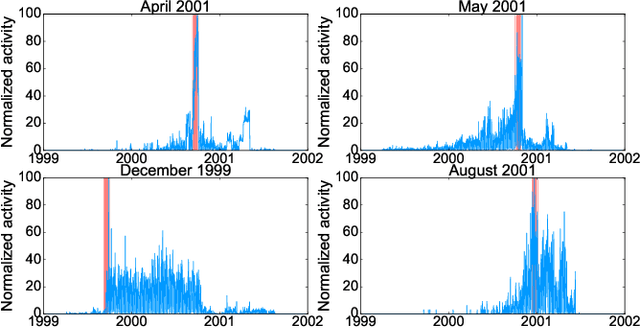Kirell Benzi
Anomaly detection in the dynamics of web and social networks
Jan 22, 2019



Abstract:In this work, we propose a new, fast and scalable method for anomaly detection in large time-evolving graphs. It may be a static graph with dynamic node attributes (e.g. time-series), or a graph evolving in time, such as a temporal network. We define an anomaly as a localized increase in temporal activity in a cluster of nodes. The algorithm is unsupervised. It is able to detect and track anomalous activity in a dynamic network despite the noise from multiple interfering sources. We use the Hopfield network model of memory to combine the graph and time information. We show that anomalies can be spotted with a good precision using a memory network. The presented approach is scalable and we provide a distributed implementation of the algorithm. To demonstrate its efficiency, we apply it to two datasets: Enron Email dataset and Wikipedia page views. We show that the anomalous spikes are triggered by the real-world events that impact the network dynamics. Besides, the structure of the clusters and the analysis of the time evolution associated with the detected events reveals interesting facts on how humans interact, exchange and search for information, opening the door to new quantitative studies on collective and social behavior on large and dynamic datasets.
Song Recommendation with Non-Negative Matrix Factorization and Graph Total Variation
Jan 13, 2016



Abstract:This work formulates a novel song recommender system as a matrix completion problem that benefits from collaborative filtering through Non-negative Matrix Factorization (NMF) and content-based filtering via total variation (TV) on graphs. The graphs encode both playlist proximity information and song similarity, using a rich combination of audio, meta-data and social features. As we demonstrate, our hybrid recommendation system is very versatile and incorporates several well-known methods while outperforming them. Particularly, we show on real-world data that our model overcomes w.r.t. two evaluation metrics the recommendation of models solely based on low-rank information, graph-based information or a combination of both.
 Add to Chrome
Add to Chrome Add to Firefox
Add to Firefox Add to Edge
Add to Edge